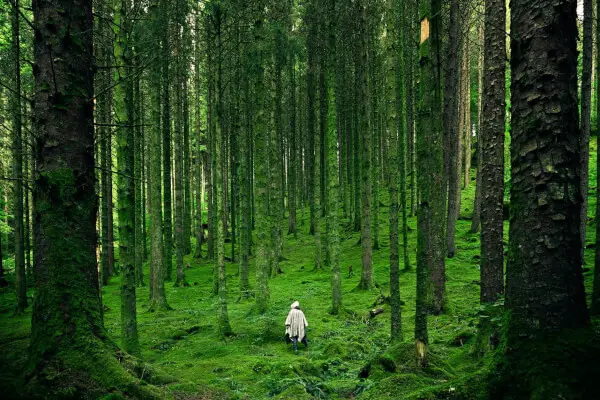“Leave no trace” – it’s a phrase we hear all the time, from scout camp to high-level outdoor leadership courses to day hikes with eco-minded friends. But what does it actually mean, and why do we do it? Leave no trace is the namesake and philosophy of the Leave No Trace Center for Outdoor Ethics – a nonprofit dedicated to limiting our impact on others and the environment when we venture into the wilderness.
The reach of the philosophy has spread far beyond one organization, however, and these seven LNT principles make up the golden rules of considerate backpacking.
See also: Biodegradable Toilet Paper: An Eco-Friendly Solution for Backpackers
Following the LNT philosophy benefits the environment, wildlife, and history of the places we visit by preserving it in its natural state. It also benefits other visitors and, surprisingly, ourselves!
When we practice leaving no trace, we can avoid accidents, utilize the environment more effectively, and experience nature in all its glory. This article will give you a run-down of the seven principles – what they are, why they matter, and how you can use them in all your future adventures!
Plan, Plan, Plan
He who fails to plan, plans to fail. At least that’s what they say. Enter principle #1! Planning your trip in advance seems like a no-brainer as far as good ideas go, but what does it have to do with leaving no trace? Well, first of all, nothing ruins a nice weekend in the woods like the sound of a rescue helicopter. For the best ultralight backpacking list you can use, see our article on this important topic.
Planning ahead allows you to understand the risks of your destination – the weather, terrain, gear and experience requirements, and wildlife hazards that can make or break your experience. When we find ourselves stressed out, hungry, dehydrated, or hypothermic, we’re more likely to make poor choices like cutting across trails, disrupting wildlife. We’re also a lot more likely to get hurt, and rescues big and small leave a big impact.
Planning ahead isn’t always about life and limb, but it’s always important. There are many other pieces of the planning puzzle that you can consider. Think about your group size – do you need to have fourteen friends come along, or will four do? If your group is large, try breaking up into several smaller groups to reduce noise, trail erosion, and fire impact.
Think about your food – can you repackage your food before your trip to reduce garbage? Not only will you reduce the weight you have to carry, but you’ll reduce your risk of accidental littering. Think about your timeframe – do you need to go to Moab during Jeep Week? Try to plan trips in popular destinations during times when they’re a little less busy to reduce your contribution to noise and light pollution.
If you’re feeling bold, you can even plan in the off season – many summer destinations offer beautiful and exciting snowshoeing or skiing options in the winter.
Utilize Your Space
What’s small, brown, and takes 5,000-10,000 years to grow back after you step on it? Cryptobiotic soil! This crusty, microbiotic soil topper found in the deserts of the Southwest is just one of the many reasons why principle #2, utilizing spaces properly, is so important.
One of the joys of backpacking is being able to experience natural places in a pristine state, and the core of leave no trace philosophy is leaving them that way. Limiting our impact on soil erosion and water pollution is key to making this happen. Here’s how to make that happen:
Stick to the trail
It’s tempting to veer down to that clearing and see what’s in there, but in doing so you squish vegetation or destroy soil that’s taken years, sometimes centuries to grow! Trail crews work hard to make your experience enjoyable, give them some credit and stay on the path.
Don’t cut corners
Cutting switchbacks is never a good idea. First of all, you might throw out your knee with those steep angles (believe us, it happens). More importantly, however, cutting switchbacks contributes to soil erosion, which pollutes water and prevents vegetation growth. When others see the trails you make, they tend to follow them, and the problem gets worse.
Camp at least two hundred feet away from water
This is another one of those win-win tips. Camping away from water prevents seepage of all our human-y stuff (like insect repellent, cooking oils, battery mold, and waste) into water sources, which are vital parts of every ecosystem. 200 feet may seem like a lot, but the ground surrounding bodies of water absorbs a massive amount of moisture and hosts a plethora of life.
Among that life, and this is the win-win part, aremosquitoes. Staying away from water means avoiding the worst of the bloodsucking beasts.
Avoid using unaffected places
Finally, if you’re exploring cross-country or an untouched area, avoid using areas where impact is beginning. If a trail isn’t established, don’t establish it – and the same goes for campsites.
Dealing With Waste
As the name suggests, this principle concerns what you bring into the wilderness, and what you bring out. At its most basic, the third principle preaches that if you pack it in, you pack it out. Reducing waste leaves our natural surroundings as pristine as we find it for the next person.
It also prevents poisoning and choking wildlife, contaminating standing and running water, damaging soil, and disrupting the often-fragile ecologies of the places we live to visit. Here are some tips for dealing with your waste effectively.
Minimize waste before you go
Remember principle #1? That one comes in handy here. You don’t have to worry about packing out trash if you don’t create trash, so try repackaging food and toiletries in reusable bags.
Scent-proof, sealable plastic bags like those made by OPSAK work great and can even withstand boiling water for dehydrated meals. Then simply seal ‘em up and throw them in your pack to use next time.
Do a garbage check
Always check your campsite or rest stops for garbage before leaving. If you’re travelling with children, offer ten cents or another small reward per piece of trash found. Keep a small sack or easily accessible pocket dedicated to garbage, and stock some hand sanitizer or wipes if you pick up other people’s trash as well.
Respect the nature around
When nature calls, make sure you are at least 200 feet away from natural water sources. For solid waste, dig a hole at least 6-8 inches deep and cover it when you’re done. Never bury your TP – pack it out! If you’re in a rocky area, high-traffic area, or location where restrictions require packing out waste, invest in some “wag bags”. These handy little bags reduce smell and prevent leaking, allowing you to carry out your waste without a second thought.
Don’t Touch That!
You’ve probably heard that you should “take only pictures, leave only footprints” before, and it’s solid advice (although, as we mentioned in principle #2, you shouldn’t really be leaving footprints either). The reason for this is because that really cool thing you find on a mountaintop?
It’s really cool because it’s important! Everything from tiny grasses to pottery shards to animal bones to elaborate blooming flowers plays a role in the place you find it. Let’s go over a few of the things people are usually tempted to take, why you shouldn’t, and what you can do instead:
Animal bones or other remains – Some people really like bones. Some people really like feathers. Some people really like porcupine quills, boar teeth, snakeskins, and so on. When you spot one of these items on the trail, the temptation can be to pick it up and take it home. However, taking animal remains not only prevents others from seeing and learning from them, but it puts you at risk.
Touching anything no-longer-living exposes you to disease, and it’s often illegal. For instance, taking feathers from a dead bird of prey is often a felony, even if you didn’t kill it! Instead of taking remains, invest in a wildlife field guide and journal about the identifying marks on what you find. Try to identify the bones or teach your friends about the different types of feathers and their purposes.
Unique or pretty flowers
Of course people want to pick flowers – what better way to express your dedication than giving your lover a hand-picked batch of Edelweiss from the top of a mountain? However, picking flowers, even when it seems like there are plenty, can do a lot of damage. Some plants rely on each other to grow and picking even a few can be disastrous.
Alpine and desert plants often take years, even decades to come to bloom and one swift pick will destroy their hope of reproduction completely. Still others are actually invasive species, and hauling them around on your backpack can spread their seeds far and wide. Instead of picking flowers, bring a sketchbook and draw them. Bring a guidebook or pamphlet on species native to your location and learn about their life cycles and their uses throughout history.
Artifacts or fossils
It is a very, very cool feeling to find an artifact – and everyone who walks the same path as you should get to experience it! These items are bits of history that are irreplaceable, and as amazing as they are, most of us don’t know how to interpret them or take care of them properly. Leave artifacts where you find them and look, but don’t touch. Make rubbings of fossils and take lots of pictures, and if on public lands, be sure to give the rangers a heads up!
Minimize Your Fire Impact
As portable stoves and minimalist backpacking become more popular, traditional campfires have lost some of their influence. If you decide to have a fire, however, use principle #4 and minimize your fire impact.
First, make sure fires are allowed where you are! Even if you’ve had fires there before, dry conditions, nearby fires, or recent burns can impact the safety of campfires as well as the amount of smoke in the air – both important for the safety of humans and wildlife alike. See our guidelines on fire safety to be protected at all times.
Second, use fire pits, mounds, or rings whenever possible. If there is no fire pan or established ring, clear the area of debris before lighting up. Keep your fire small – no bigger than necessary for heat, warmth, and light (we know bonfires are fun, but save them for the backyard cookouts).
Finally, make sure your fire is dead out. If there is water available, use it! If not, cover ashes in sand and scatter ashes to ensure the embers are out before leaving your fire unattended. Remember, you are responsible for preventing wildfires!
Respect Wildlife
This principle seems like a no-brainer, but it’s the one that seems to cause the most trouble. The most important thing to keep in mind around wild animals is that you are in their house – most of the time, they don’t mind you being there.
But if you disrespect their space, you can bet there will be some conflict. Here are some tips for interacting with wildlife in an ethical, and safer, way:
Watch from a distance
The meaning of “distance” varies according to the animal, but all animals require it. Obviously, if you see a grizzly bear mama with a cub, you want to leave some room. But that cute little squirrel? What’s the harm? Remember that all wild animals are wild – and they should stay that way! Even if an animal seems friendly, they might not be. If an animal is friendly towards humans, it often leads to behaviors that require relocation or euthanasia.
Never feed the animals
Feeding animals is not only bad for their health (are you a wild mammal nutritionist? Probably not), but bad for their behavior as well. When animals learn to associate people with food, it often leads to problem behaviors like destroying camps, cars, and trashcans, and even hurting people. The usual solutions for these problems doesn’t benefit the animals, so while it may be really cool to get up close to the wildlife, consider the longer-term impacts.
Store your food properly
Most unwanted encounters with animals in the wilderness are caused by one thing: food. Wild animals of all shapes and sizes have a habit of seeking out our freeze-dried stroganoff and will go to great lengths to get our candy bars. This can create some pretty big problems for us, but it can also be a big issue for animals who will ingest dangerous foods and garbage along with the good stuff. For tips on how to hang a bear bag, check out our article for more information.
Backpackers and campers sometimes have to act in self-defense against foraging animals, and that definitely leaves a trace. Avoid these situations by storing food in scent proof containers away from camp, hanging if possible. In bear country, use bear cans and store food, dishes, and garbage several hundred yards away from tents.
Respect Others
We’ve made it to the final principle of leave no trace – respecting others. Just like the wild animals, other humans must be respected when we are out and about. Perhaps the most golden rule-esque of these golden rules, this principle is all about allowing others to experience nature how you want to experience it!
This means practicing all of the above six principles regularly and sharing them with those you encounter, and it also means using a little bit of common trail courtesy.
Yield to people on the trail
Step to the side for people coming towards you and passing you from behind – no need to try and outpace them.
Watch your dog
If you bring a dog along, keep him or her on leash. Not everyone likes dogs, and if there are other canines around, you can avoid sometimes disastrous encounters with anxious dogs by simply using a leash.
Avoid loud noises
It may seem like impressing Susan with your acoustic guitar cover of “American Pie” is the most important part of a backpacking trip, but consider letting the sounds of nature take over.
Yelling, playing music, screaming, and even loud talking can be extremely disruptive to others who are in the wilderness to get away from the sounds of their usually busy life, and just your voice can carry miles in the quiet of nature. Stick to soft noises, and try to limit noise as much as possible after dark.
Summing Up
We’ve gone over the seven leave no trace principles – from planning your trip to hiking the trail to setting up camp. We’ve talked about some of the considerations for packing out waste, dealing with wildlife, and encountering cool stuff along the way.
Most importantly, we’ve gone over why leaving no trace is important – not only to others, but to the environment and to yourself. Now get out there and practice!
For more hiking safety tips, take a look at our article on this topic for more information.
Featured Image Source: https://www.pexels.com/photo/person-walking-between-green-forest-trees-15286/








